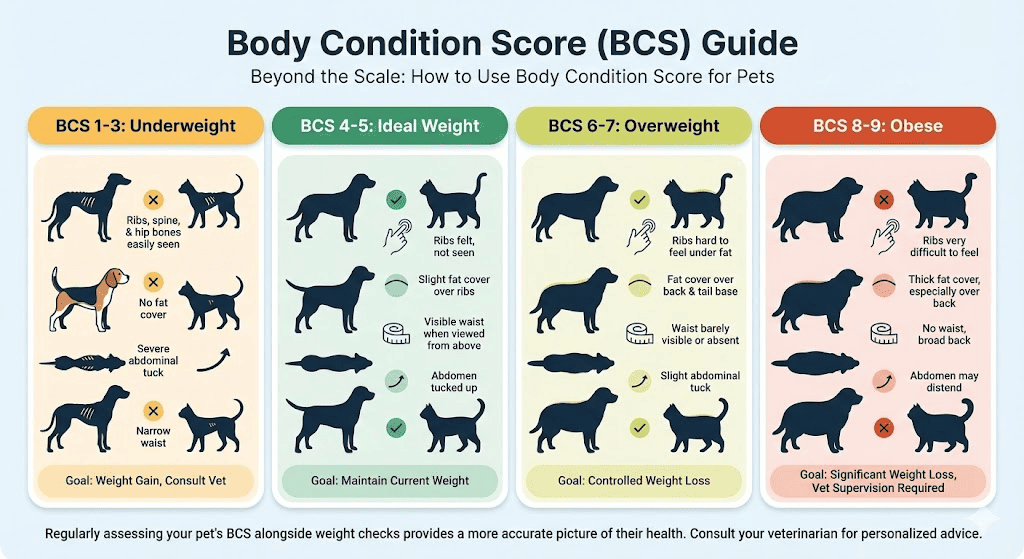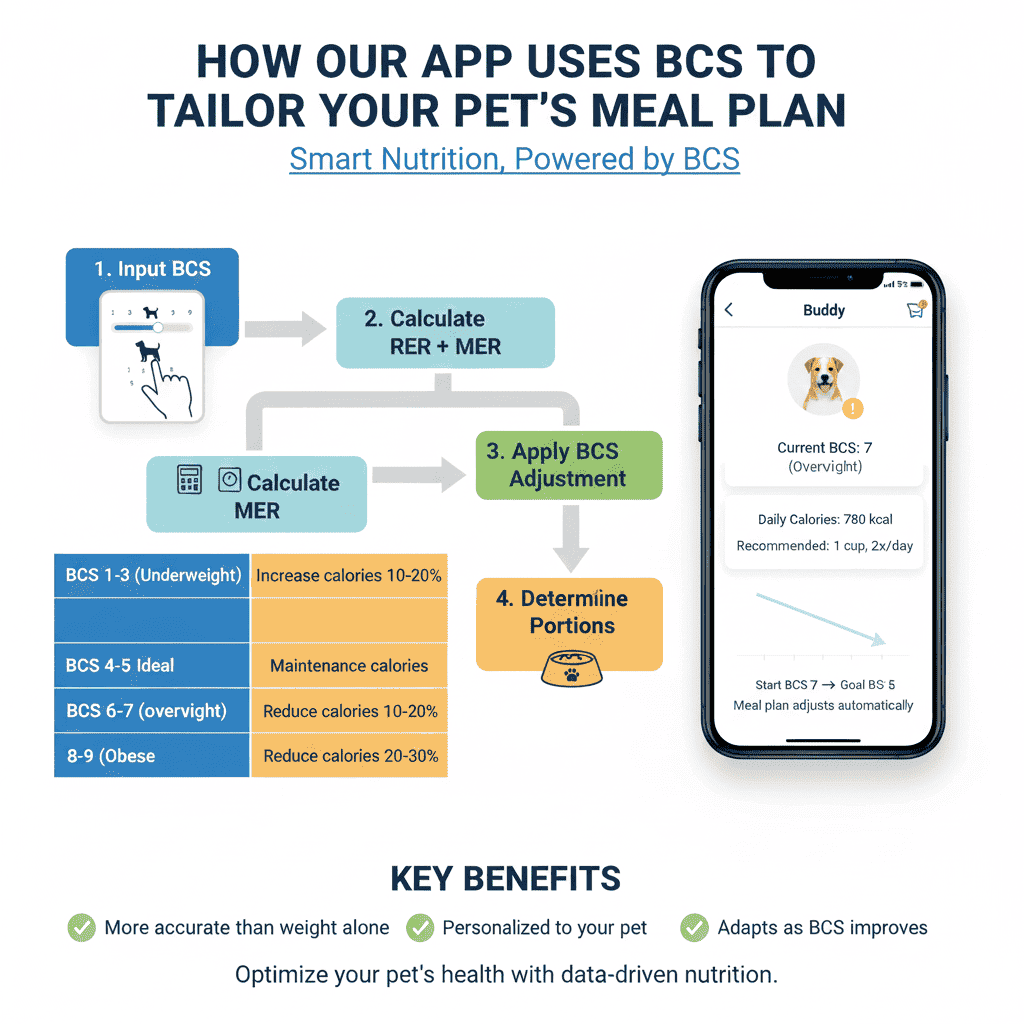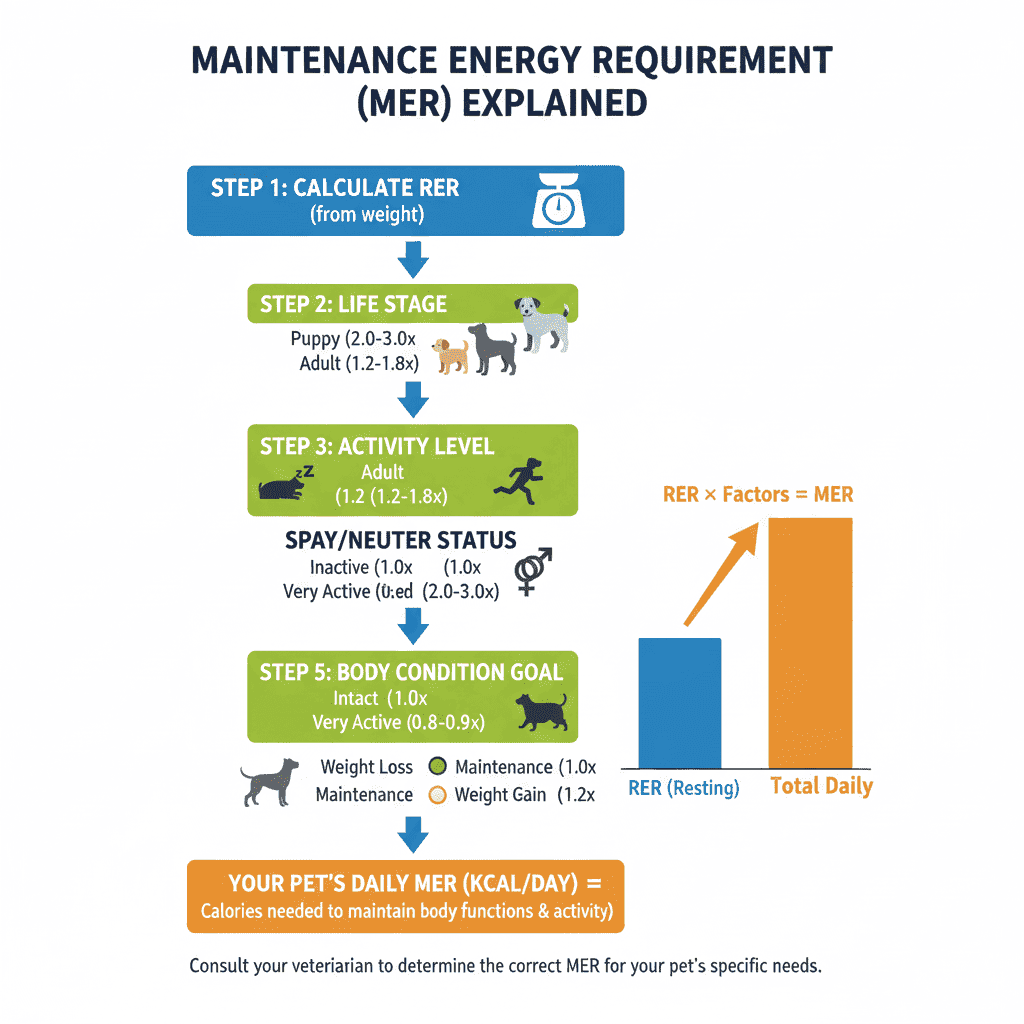You step on the scale every morning, watching those numbers with anticipation. But when it comes to your pet's health, the scale is only telling you part of the story—and sometimes, it's the wrong part entirely.
A 50-pound Labrador might be perfectly healthy, while another 50-pound Labrador could be dangerously overweight. A 10-pound cat might be at their ideal weight, while another 10-pound cat could be underweight or obese. The number on the scale doesn't account for frame size, muscle mass, bone structure, or body composition.
This is where Body Condition Score (BCS) becomes your most powerful tool. It's a standardized, hands-on method used by veterinarians worldwide to assess whether your pet is too thin, just right, or carrying excess weight. Unlike the scale, BCS evaluates your pet's actual body composition, giving you a clear picture of their health status.
What is Body Condition Score?
Body Condition Score is a standardized visual and tactile assessment system that evaluates your pet's body fat and muscle mass. It uses a 9-point scale (or sometimes a 5-point scale) where:
- BCS 1-3: Underweight (too thin)
- BCS 4-5: Ideal weight (healthy)
- BCS 6-7: Overweight
- BCS 8-9: Obese (severely overweight)
The beauty of BCS is that it works regardless of your pet's breed, size, or frame. A Great Dane and a Chihuahua can both be assessed using the same criteria, because BCS focuses on what you can feel and see, not what the scale says.
Why BCS Matters More Than Weight
The Scale's Limitations
Weight alone is misleading because:
-
Frame Size Varies: Two dogs of the same breed can have vastly different frame sizes. One might be naturally larger-boned and heavier, while another is more petite.
-
Muscle vs. Fat: A muscular, athletic dog might weigh more than a sedentary dog of the same size, but the muscular dog is healthier. The scale can't distinguish between muscle and fat.
-
Breed Differences: A healthy Greyhound will look very different from a healthy Bulldog at the same weight. Their ideal body compositions are completely different.
-
Age and Life Stage: A growing puppy's weight changes daily. An older pet might lose muscle mass but gain fat, staying at the same weight while becoming less healthy.
What BCS Reveals
BCS tells you:
- Body fat percentage: How much of your pet's body is fat vs. muscle
- Muscle condition: Whether your pet has adequate muscle mass
- Health risks: Obesity-related conditions develop based on body fat, not weight
- Progress tracking: You can see improvements even when weight changes are minimal

The Three Key Areas to Assess
When performing a BCS check, you'll evaluate three critical areas:
1. Ribs
What to feel for:
- BCS 4-5 (Ideal): Ribs are easily felt with light pressure, like feeling the back of your hand. You can count individual ribs, but they shouldn't be visible.
- BCS 1-3 (Too Thin): Ribs are very prominent and easily visible. There's little to no fat covering them.
- BCS 6-9 (Overweight): Ribs are difficult to feel, requiring firm pressure. There's a thick layer of fat covering them.
2. Waist (Viewed from Above)
What to look for:
- BCS 4-5 (Ideal): A clear, visible waistline behind the ribs. The body should have an hourglass shape when viewed from above.
- BCS 1-3 (Too Thin): An exaggerated, severe waistline. The body looks like an extreme hourglass or even concave.
- BCS 6-9 (Overweight): No visible waistline. The body is straight or even wider at the waist than at the ribs.
3. Abdominal Tuck (Viewed from the Side)
What to observe:
- BCS 4-5 (Ideal): A clear abdominal tuck. The belly should curve upward from the ribcage toward the hips.
- BCS 1-3 (Too Thin): An extreme abdominal tuck. The belly is severely tucked up.
- BCS 6-9 (Overweight): No abdominal tuck, or the belly sags downward. The underside is straight or drooping.
How to Perform a BCS Check at Home
For Dogs
-
Stand your dog on a flat surface and view them from the side and from above.
-
Feel the ribs:
- Place your hands on both sides of the ribcage
- Apply light pressure with your fingertips
- Can you easily feel individual ribs? (Ideal)
- Do you need to press hard to feel ribs? (Overweight)
- Are ribs visible without touching? (Underweight)
-
Check the waist (from above):
- Stand directly above your dog
- Look for a visible indentation behind the ribs
- Is there a clear waistline? (Ideal)
- Is the body straight or wider at the waist? (Overweight)
-
Assess the abdominal tuck (from the side):
- View your dog from the side
- The belly should curve upward from the chest
- Is there a clear upward curve? (Ideal)
- Does the belly sag or hang? (Overweight)
For Cats
-
Have your cat stand naturally on a flat surface.
-
Feel the ribs:
- Gently run your hands along the ribcage
- You should be able to feel ribs with light pressure
- If you can't feel ribs easily, your cat is likely overweight
-
Check the waist (from above):
- View from directly above
- Look for a slight indentation behind the ribs
- A healthy cat should have a subtle waistline
-
Assess the abdominal area:
- From the side, check for a slight tuck
- A small "pouch" is normal in cats, but it shouldn't be excessive
- If the belly hangs low, your cat is likely overweight
Understanding Each BCS Level
BCS 1-3: Underweight (Too Thin)
Characteristics:
- Ribs, spine, and hip bones are easily visible
- No body fat can be felt
- Severe abdominal tuck
- Loss of muscle mass may be evident
Health Risks:
- Weakened immune system
- Poor wound healing
- Muscle wasting
- Organ dysfunction
- Increased risk of illness
Action: Consult your veterinarian immediately. Underweight pets may have underlying health conditions that need treatment.
BCS 4-5: Ideal Weight (Perfect)
Characteristics:
- Ribs easily felt with light pressure but not visible
- Clear waistline when viewed from above
- Abdominal tuck visible from the side
- Good muscle definition
Health Benefits:
- Optimal energy levels
- Reduced risk of obesity-related diseases
- Better mobility and joint health
- Longer lifespan
- Improved quality of life
Action: Maintain this condition! Continue with current feeding and exercise routine.
BCS 6-7: Overweight
Characteristics:
- Ribs difficult to feel, requiring firm pressure
- Waistline is barely visible or absent
- Abdominal tuck is reduced or absent
- Fat deposits may be visible on the back and base of tail
Health Risks:
- Increased risk of diabetes
- Joint problems and arthritis
- Heart and respiratory issues
- Reduced lifespan
- Decreased quality of life
Action: Begin a weight loss program under veterinary supervision. Reduce calories by 10-20% and increase exercise gradually.
BCS 8-9: Obese (Severely Overweight)
Characteristics:
- Ribs cannot be felt, even with firm pressure
- No visible waistline
- No abdominal tuck
- Obvious fat deposits on neck, limbs, and tail base
- Difficulty walking or breathing may be evident
Health Risks:
- Severe risk of diabetes
- Crippling joint disease
- Heart failure
- Respiratory distress
- Significantly shortened lifespan
- Poor quality of life
Action: Immediate veterinary consultation required. A structured weight loss plan is essential and should be medically supervised.
Special Considerations
Long-Haired or Fluffy Pets
For pets with thick coats, rely more on touch than sight:
- Use your hands to feel for ribs, waist, and body shape
- The coat can hide body condition, so tactile assessment is crucial
- Consider having a professional assessment during grooming when the coat is shorter
Senior Pets
Older pets may have:
- Reduced muscle mass (sarcopenia)
- Different body composition
- Health conditions affecting weight
- Reduced mobility affecting exercise
BCS helps distinguish between healthy aging and concerning weight changes.
Breed-Specific Considerations
Some breeds have unique body types:
- Sighthounds (Greyhounds, Whippets): Naturally lean with visible ribs at ideal weight
- Bulldogs, Pugs: Naturally stocky; focus on waist and abdominal tuck
- Working Breeds: May appear heavier due to muscle mass; feel for fat vs. muscle
How BCS Integrates with Your Pet's Meal Plan
At PetMealPlanner, we use your pet's Body Condition Score as a fundamental input for creating personalized meal plans. Here's how it works:
-
Initial Assessment: When you input your pet's BCS, our system adjusts calorie recommendations accordingly.
-
Weight Goal Setting:
- BCS 1-3: Automatically sets weight gain goals with increased calories
- BCS 4-5: Maintains current weight with appropriate maintenance calories
- BCS 6-7: Sets weight loss goals with reduced calories (typically 10-20% reduction)
- BCS 8-9: Sets aggressive weight loss goals with significant calorie reduction (20-30%)
-
Ongoing Monitoring: As your pet's BCS improves, the meal plan adjusts automatically, ensuring they reach and maintain their ideal body condition.
-
Precision Portioning: BCS helps us calculate the exact amount of food needed, accounting for body composition rather than just weight.
When to Reassess BCS
Regular checks:
- Monthly for pets on weight management programs
- Every 3 months for pets at ideal weight
- Weekly during active weight loss or gain programs
- After major life changes (spay/neuter, illness, activity level changes)
Professional assessment:
- Have your veterinarian assess BCS during annual checkups
- Ask for BCS documentation in your pet's medical records
- Request reassessment if you're unsure about your at-home evaluation
Common Mistakes to Avoid
-
Relying only on the scale: Weight doesn't tell the whole story.
-
Comparing to other pets: Each pet has their own ideal body condition.
-
Ignoring muscle loss: A pet can be "normal weight" but have poor muscle condition.
-
Not reassessing regularly: Body condition changes over time.
-
Being too lenient: Many pet owners underestimate their pet's weight status.
The Bottom Line
Body Condition Score is the gold standard for assessing your pet's health status. It's more accurate, more informative, and more actionable than weight alone. By learning to perform BCS checks at home, you become an active partner in your pet's health management.
Remember: The goal isn't a specific number on the scale—it's achieving and maintaining a BCS of 4-5, where your pet has optimal body composition for a long, healthy, and active life.
Ready to assess your pet's body condition and create a personalized meal plan? Use our pet meal planner to get started, and don't forget to discuss your pet's BCS with your veterinarian at their next checkup.
For detailed guides on performing BCS checks for specific pets, see our articles: How to Perform a Body Condition Check on Your Dog at Home and How to Perform a Body Condition Check on Your Cat at Home.


